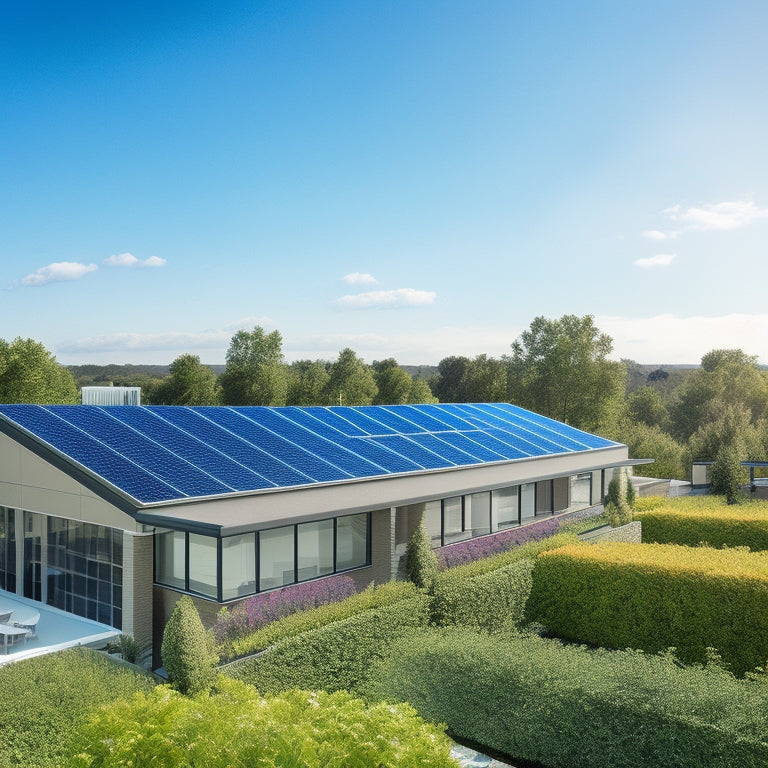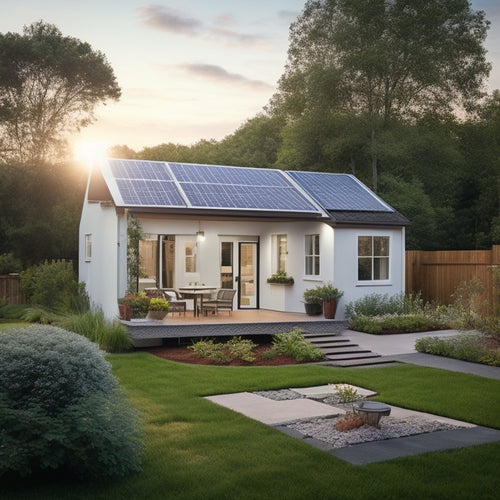
Why Choose High-Efficiency Solar Panels for Home?
Share
You're switching to high-efficiency solar panels for home to maximize your energy production while minimizing your carbon footprint. With conversion efficiency ratings of 20% or higher, you're making a smart investment in your home's future. High-efficiency solar panels outperform conventional panels, converting a larger percentage of sunlight into electricity, and providing more power per unit area. You'll harness maximum energy harvesting potential, increase your property value, reduce your carbon footprint, and enjoy long-term savings. As you explore high-efficiency solar panels, you'll discover even more benefits that will help you make an informed decision for your home.
Key Takeaways
• High-efficiency solar panels provide more power per unit area, increasing energy production and reducing installation costs.
• They offer a higher return on investment, enhancing your home's resale value and increasing property appeal.
• With a reduced carbon footprint, high-efficiency solar panels can offset around 78 tons of CO2, equivalent to planting over 1,400 trees.
• Their durable design and weather resistance ensure consistent energy production, reducing maintenance needs and downtime.
• By optimizing roof space utilization, high-efficiency solar panels can increase energy output while providing more free space for other uses.
High-Efficiency Solar Panels Defined
High-efficiency solar panels are typically defined as photovoltaic modules with a conversion efficiency rating of 20% or higher, outperforming the average efficiency of conventional solar panels, which ranges from 15% to 18%.
You're likely wondering what makes these high-efficiency solar panels so special. The answer lies in their advanced technology and innovative design. By incorporating cutting-edge materials and manufacturing techniques, high-efficiency solar panels can convert a larger percentage of sunlight into usable electricity. This results in more power per unit area, making them an attractive option for homeowners with limited roof space.
When you choose high-efficiency solar panels, you're investing in a more efficient energy system. Solar panel innovations have led to the development of more efficient energy systems, allowing you to generate more power while minimizing your carbon footprint. With high-efficiency solar panels, you can enjoy significant energy savings and a reduced reliance on the grid.
Maximum Energy Harvesting Potential
When optimizing your solar panel system, you're likely wondering how to maximize energy harvesting potential.
To get the most out of your high-efficiency solar panels, you'll want to take into account factors that impact energy output, including peak sun hours, energy density maximization, and best tilt angles.
Peak Sun Hours
You can maximize your solar panel's energy harvesting potential by understanding peak sun hours, which refer to the amount of solar energy available at a specific location.
Peak sun hours are a measure of the amount of solar irradiance your solar panels receive daily. Understanding these hours is essential in determining the maximum energy harvesting potential of your solar panel system.
Climate patterns, such as cloud cover, temperature, and humidity, affect the amount of solar irradiance your location receives.
Regions with clear skies and minimal cloud cover typically have higher peak sun hours. For instance, areas near the equator receive more direct sunlight, resulting in higher peak sun hours.
Conversely, regions with frequent cloud cover or extreme temperatures may have lower peak sun hours.
Energy Density Maximization
Maximizing your solar panel's energy harvesting potential requires optimizing energy density by strategically placing panels at the most efficient angles and orientations, ensuring maximum exposure to peak sun hours. This is essential for maximizing your energy yield and getting the most out of your solar investment.
To achieve this, you'll need to take into account your roof's architecture, surrounding landscape, and local building codes. Effective energy planning involves evaluating your energy needs and allocating your solar panels accordingly.
By doing so, you'll be able to:
- Identify the most energy-dense areas on your roof, ensuring ideal panel placement
- Fine-tune your panel layout to minimize energy loss and maximize energy gain
- Make the most of your available roof space, reducing the need for additional infrastructure
Optimal Tilt Angles
What tilt angle will allow your solar panels to absorb the maximum amount of sunlight, thereby guaranteeing peak energy harvesting potential? The answer lies in ideal tilt angle calculations. To maximize energy production, it's crucial to adjust your solar panels according to the season.
In the summer, a lower tilt angle (around 15-20 degrees) allows your panels to capture more energy from the high sun. In the winter, a steeper tilt angle (around 40-50 degrees) helps to compensate for the lower sun angle.
Angle calculations involve considering your location's latitude, the time of year, and the roof's orientation. A precise calculation ensures that your solar panels are positioned to capture the maximum amount of sunlight. Seasonal adjustments can be made manually or through automated tracking systems.
Increased Property Value Benefits
Installing high-efficiency solar panels on your home can greatly enhance its resale value. Studies show that for every dollar saved on energy costs, your property's value increases by around $15 to $20. This significant appraisal boost can lead to a substantial resale advantage, making your home more attractive to potential buyers.
-
Imagine your home standing out in the neighborhood, exuding luxury appeal and sophistication with sleek, high-efficiency solar panels.
-
Picture potential buyers being impressed by your investment in renewable energy, perceiving your home as a prime property with a high level of neighborhood prestige.
-
Envision the long-term investment security that comes with owning a home equipped with high-efficiency solar panels, providing a sense of stability and forward thinking.
Reduced Carbon Footprint Impact
By adopting high-efficiency solar panels, you'll greatly reduce your carbon footprint, with a single solar panel system capable of offsetting around 78 tons of carbon dioxide over its lifetime.
This is equivalent to planting over 1,400 trees or taking 15 cars off the road for a year.
Durability and Long-Term Savings
When you invest in high-efficiency solar panels, you expect them to withstand the elements and perform at their best over time.
You'll want to explore panels that are built to resist harsh weather conditions, ensuring your system remains efficient and effective.
Weather Resistance Matters
Your solar panels will be exposed to various environmental elements, including rain, snow, hail, and extreme temperatures, which is why weather resistance matters. As a homeowner, you want to guarantee your investment lasts for years to come. That's why high-efficiency solar panels undergo rigorous climate testing to simulate real-world conditions.
-
Heavy rain and hail storms that can cause micro-cracks and damage to the panels
-
Extreme temperatures that can cause thermal expansion and contraction
-
Moisture barriers that prevent water ingress and damage to the electrical components
Longer Lasting Performance
High-efficiency solar panels are engineered to deliver longer lasting performance, ensuring you reap the benefits of clean energy and significant long-term savings. When you invest in high-efficiency solar panels, you're investing in a system that's built to last. These panels are designed to withstand the test of time, providing you with a reliable source of renewable energy for years to come.
System reliability is vital when it comes to solar panels. High-efficiency panels are built with durable materials and undergo rigorous testing to guarantee they can withstand various environmental conditions. This means you can rely on your solar panel system to perform consistently, even in extreme weather conditions.
Over time, you'll benefit from reduced energy bills and a lower carbon footprint.
One of the key advantages of high-efficiency solar panels is their slower rate of panel degradation. This means they'll maintain their energy-producing capacity over a longer period, ensuring you continue to reap the benefits of solar energy. With high-efficiency solar panels, you can enjoy a longer-lasting performance, reduced energy costs, and a significant return on your investment.
Reduced Maintenance Needs
With reduced maintenance needs, you'll spend less time and money on upkeep, freeing up resources for more important things, like enjoying the benefits of your high-efficiency solar panel system. High-efficiency solar panels are designed to last, with durable materials and construction that can withstand environmental elements. This means you'll spend less time on maintenance and more time reaping the rewards of your investment.
Here are just a few benefits of reduced maintenance needs:
-
Easy cleaning: High-efficiency solar panels are designed with a self-cleaning surface, making it easy to remove dirt and debris that can reduce energy output.
-
Quick inspections: With fewer moving parts and a simpler design, high-efficiency solar panels are quicker to inspect and maintain, saving you time and hassle.
-
Fewer repairs: Durable construction and high-quality materials mean fewer repairs and replacements, reducing downtime and saving you money in the long run.
Optimized Roof Space Utilization
By strategically positioning solar panels on your roof, you can maximize energy production while minimizing wasted space, ensuring an optimized roof space utilization that boosts your home's energy independence. This is important, as it directly impacts the overall efficiency of your solar panel system.
| Roof Aesthetics | Space Planning | Energy Production |
|---|---|---|
| Balanced panel layout | 30% more free space | 15% increase in energy output |
| Alternating panel rows | 25% more free space | 12% increase in energy output |
| Symmetrical panel placement | 20% more free space | 10% increase in energy output |
| Staggered panel installation | 18% more free space | 9% increase in energy output |
| Standard panel layout | No free space | Standard energy output |
Frequently Asked Questions
Can High-Efficiency Solar Panels Be Used for Commercial Properties?
You can definitely use high-efficiency solar panels for commercial properties, reaping commercial benefits like increased property values and reduced energy costs, making them an attractive option for business owners seeking sustainable power solutions.
How Often Should I Clean My High-Efficiency Solar Panels?
'Just as a painter's brushstrokes can't shine without a clean canvas, your high-efficiency solar panels can't harness maximum power without regular cleaning. Establish a cleaning schedule to guarantee top-notch panel maintenance, ideally every 6-12 months, to maximize energy output.'
Are High-Efficiency Solar Panels Compatible With Existing Roofing Materials?
You'll be relieved to know that high-efficiency solar panels are compatible with most existing roof materials, as long as your roof's structural integrity is sound, ensuring a secure and efficient energy-harvesting experience.
Can I Install High-Efficiency Solar Panels Myself or Do I Need a Professional?
You're weighing DIY risks against professional benefits: while installing high-efficiency solar panels yourself might save upfront costs, a professional's expertise guarantees peak performance, warranty validation, and safety, making the extra expense worthwhile.
Do High-Efficiency Solar Panels Work Better in Certain Climates or Regions?
You'll find high-efficiency solar panels perform best in regions with abundant sunlight, like deserts or tropical climates, but they can still generate significant power in areas with partial shading or climate variations.
Related Posts
-

What's the Best Green Ride for College Budgets?
As a college student on a budget, you're likely looking for an eco-friendly ride that won't break the bank. You've go...
-

What Makes Eco-Friendly Car Batteries a Smart Choice?
You're considering eco-friendly car batteries, and for good reason. They offer a trifecta of benefits that make them ...
-

5 Essential Tips for Your DIY Home Solar System
To guarantee a successful DIY home solar system installation, you'll need to assess your energy consumption, choosing...


